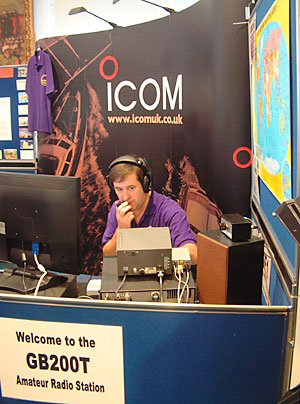GB200T - Special Event Station Celebrating the Bi-Centenary of the Battle of Trafalgar

The operating station was set up in a 14ft by 10ft area inside the E- Library of the National Maritime Museum. The main HF station was set up so that visitors could see the operator face-on when they approached the station. The other two operating positions afforded a side-on view to the public. As in previous special event stations it was very important not just to show the back of someone's head hunched over the radio. All three stations were fitted with an audio amplifier and loudspeaker independent of the headset audio so that visitors could hear what was going on. There were three operating positions. HF1 was on 10, 15 and 20m and used an Icom IC-756PROIII and an Acom 1010 amplifier. Dave Lawley, G4BUO, HF Manager of GB200T said, 'Because we were at the low part of the sunspot cycle, the majority of contacts were made on 20m but there were also some good DX openings on 15m.' The second position - HF2/VHF - was used on the WARC bands 12, 17 and 30m and on 6, 2m and 70cm. Due to space limitations, HF and VHF could not be operated simultaneously, and the bulk of the contacts were made on 17 and 30m. An Icom IC-7400 was used on HF and 6m, with an Icom IC-910 for 2m and 70cm. The third position - HF3 - used the top of the line IC-7800 on 40m and 80m only. The 200 Watt output power was especially useful on 40m. Dunestar and ICE bandpass filters were used on all transceivers to minimise inter-station interference. Icom also provided a flat screen LCD monitor which was 'slaved' from the display at the centre of the transceiver's front panel. This was used to set the display of the S-meter on both receivers and the band scope. This was positioned so that it was in full view of the public and provided quite a talking point. GB200T used a four-section mobile tower, securely guyed, to support a total of eight different antennas. All were coax-fed, using almost 1500 ft of coax in total. The antenna used on HF1 was TH5 tribander at approximately 65ft, and this together with an 11 element 2m yagi were rotatable. Wire dipoles and loops were used for the other HF bands. In true nautical fashion, the tower was 'dressed overall' with the 40 international signal flags. Meticulous planning before the event and careful labelling of all coax and antennas in advance enabled the whole station configuration, inside and outside, to be put together in just three hours. GB200T used logging software called Starlog to keep a log of all contacts made by the station. This product has been successfully used on the D68C and 3B9C DXpeditions, and performed very well with most operators finding it easy to use. All contacts were fed to a central server, from which daily extracts were e-mailed to the station's webmaster, enabling people around the world to check that they had made it into the log. CVRS members loaned laptop computers for logging at each station, and these were connected on a wireless network. StarLog enabled operators to make an instant check when someone called to see if they had been worked on other bands and modes, and this encouraged callers to QSY and contact the station on other bands. The software also had 'talk' facilities so that the operator could exchange messages with people at other operating positions. Dave Lawley, G4BUO, HF Manager of GB200T added, 'All equipment worked very well. The Icom radios were easy to set up and adjust, and everyone enjoyed using the IC-7800, though in the time available it was not possible to become fully familiar with its many facilities. We were able to set up the internal memory keyer in each rig so that the rigs would put out its own CQ call when operating Morse. The IC-756PROIII interfaced easily to the Acom linear amplifier, and these two together were a very potent combination.’ GB200T Special Events Station – Post Event Reaction
Asked what had been the highlights of GB200T, Bob Treacher, M3RCV, Team Leader of GB200T said, ‘There were many highlights ranging from the tremendous enthusiasm shown by the public to the massive pile-ups, particularly on 20m and 40m.’ Asked what he thought would be the lasting testament of GB200T, Dave Lawley said, 'GB200T was the third high profile special event station organised by Cray Valley Radio Society. It will be remembered for, once again, successfully putting amateur radio in the UK in the spotlight. It provided a unique opportunity for radio amateurs around the world to share in the Trafalgar bi-centenary celebrations. With almost 14,000 contacts and several thousand visitors, the event was the perfect demonstration of our hobby. Icom UK Marketing - marketing@icomuk.co.uk
22/11/2005

